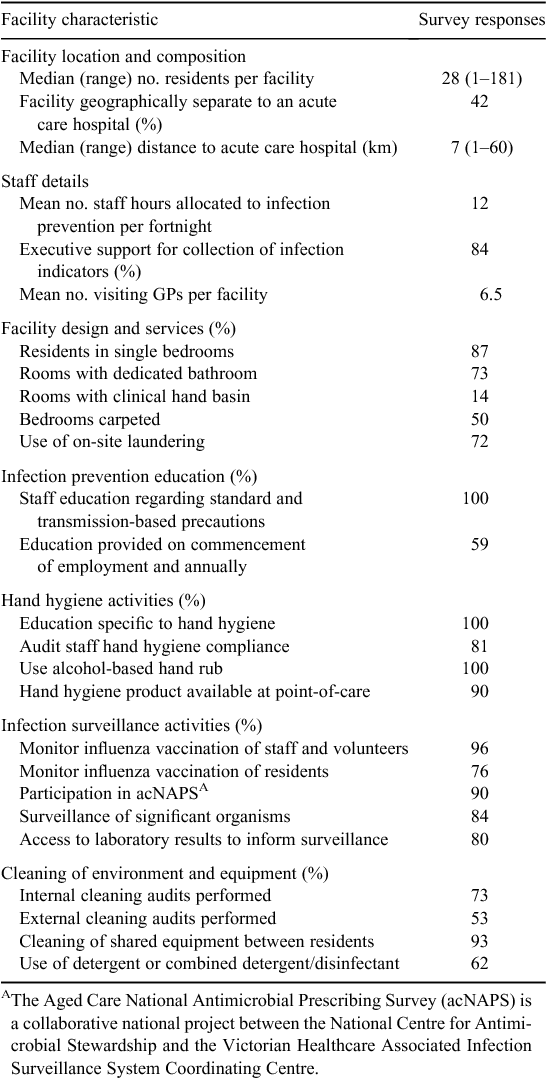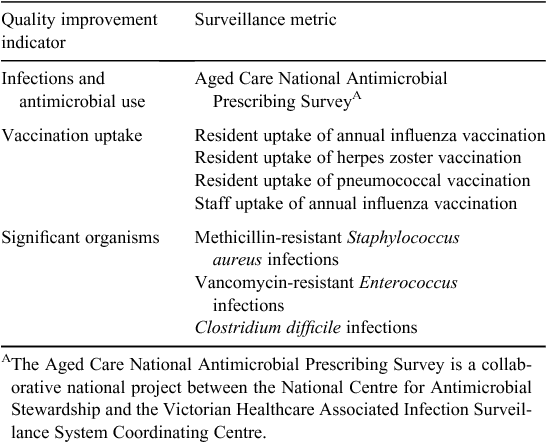Infection prevention quality indicators in aged care: ready for a national approach
N. J. Bennett A B D , J. M. Bradford A , A. L. Bull A and L. J. Worth A CA Victorian Healthcare Associated Infection Surveillance System (VICNISS) Coordinating Centre, Doherty Institute, Melbourne, Vic. 3000, Australia. Email: Jennifer.Bradford@mh.org.au; Ann.Bull@mh.org.au; Leon.Worth@mh.org.au
B National Centre for Antimicrobial Stewardship, Doherty Institute, Melbourne, Vic. 3000, Australia.
C Department of Medicine, The University of Melbourne, Parkville, Vic. 3010, Australia.
D Corresponding author. Email: Noleen.Bennett@mh.org.au
Australian Health Review 43(4) 396-398 https://doi.org/10.1071/AH18052
Submitted: 2 January 2018 Accepted: 4 June 2018 Published: 21 August 2018
Journal Compilation © AHHA 2019 Open Access CC BY-NC-ND
Abstract
Accreditation standards for Australian aged care homes include the requirement for programs to ensure infections are controlled. Effective infection prevention programs are supported by surveillance data providing the impetus for quality improvement and facilitating evaluation of interventions at the facility level. In 2016, infection control professionals employed in Victorian public-sector residential aged care services were surveyed to examine the nature and resourcing of local infection prevention programs and monitoring activities. Overall, 164 services participated (90% response rate). A high proportion (84%) reported executive support for infection surveillance, with mean allocation of 12 h per fortnight per facility for infection prevention activities. Current surveillance activities included monitoring of infections and antimicrobial use (90%), influenza vaccination compliance for staff (96%) and residents (76%) and monitoring of infection due to significant organisms (84%). A successful statewide program including eight quality indicators has subsequently been implemented in Victoria. We suggest that a national focus could strengthen this framework, ensuring a uniform strategy with enhanced benchmarking capacity. Stakeholder engagement and refinement of appropriate indicators for monitoring quality improvement in public, not-for-profit and private sectors within aged care is required.
Additional keywords: aged care, infection prevention, surveillance.
Introduction
Accreditation standards for Australian aged care homes (ACHs) include the requirement for programs to ensure infections are effectively controlled.1 Recent outbreaks have highlighted the risks associated with congruent living and the need for robust infection prevention programs that support residents to remain well and live meaningful lives.2
Effective infection prevention programs are underpinned by relevant surveillance data providing the impetus for quality improvement and facilitating evaluation of interventions.3 There is currently no coordinated national approach to continuously collect and analyse infection surveillance data in Australian ACHs.
Importance of quality indicators in aged care
In healthcare, the development of standardised quality indicators enables monitoring of performance over time and benchmarking. In hospital settings, these activities are an important element for ensuring that clinical care is aligned with best practice and supported by allocated resources and infrastructure.
Aged care settings are distinct from hospital environments for several reasons, including the provision of a ‘home-like’ environment for residents and unique workforce skills. Notwithstanding these differences, the use of quality indicators in aged care would be likely to provide many benefits: quantifiable measures of performance, clinician feedback for improvement and education and transparency for residents and carers.4 Outside Australia, quality indicators for elderly populations have been developed to monitor infections and antimicrobial use, and these are frequently used in a multimodal manner, comprising both process and outcome measures.5,6 Infection prevention quality indicators are an important element of the potential suite of measures reflecting complex care needs of Australian aged care residents.7,8
Infection prevention and surveillance programs in Victorian ACHs
In 2016, infection control professionals (ICPs) employed in Victorian public-sector residential aged care services (PSRACS) were invited to complete a survey examining their infection prevention programs and available resources. Overall, 164 services participated (90% response rate). The facilities surveyed had a median capacity of 28 residents, with medical review provided by a mean of 6.5 general practitioners per facility. Survey findings are summarised in Table 1. Notably, 84% believed they would have or probably would have the support of their executive team to commence an infection surveillance program, mean allocation to infection prevention activities was 12 staff hours per fortnight per service, 80% reported access to laboratory results for all residents and current surveillance activities included infections and antimicrobial use (90%), influenza vaccination compliance for staff (96%) and residents (76%) and monitoring of significant organisms (84%).

|
Development and use of standardised infection indicators in aged care
These findings support the fact that infection prevention and control programs and surveillance activities are generally supported and implemented at the facility level. Appreciating that surveillance activities may be strengthened further by a coordinated strategy, ICPs and clinical nurses in PSRACS commenced collection and submission of data to the Victorian Healthcare Associated Infection Surveillance System (VICNISS) Coordinating Centre in 2017, thereby ensuring uniform data submission and support for participating facilities.
Eight indicators have been developed and implemented (Table 2), incorporating process (influenza, pneumococcal and zoster vaccination uptake among residents; influenza vaccination uptake among staff; antimicrobial prescribing practices) and outcome measures (infections due to methicillin-resistant Staphylococcus aureus, vancomycin-resistant Enterococcus and Clostridium difficile). VICNISS provides data reports to participating PSRACS and the Victorian Department of Health and Human Services using standardised data metrics, electronic data handling and a secure online portal. Further, expert infection control and infectious diseases advice is available to PSRACS, ensuring uniformity of surveillance methods and implementation of best-practice interventions. This model ensures data quality and contributes to staff knowledge, both of which are essential for quality improvement activities at the service level.

|
National framework for infection indicators in aged care
Looking ahead, targets and triggers for change will be developed to ensure early detection of potential opportunities for improved performance. VICNISS has successfully developed and implemented comparable infection surveillance modules throughout Victorian acute care hospitals that are associated with the PSRACS.9 For example, annual staff influenza vaccination uptake in acute care services is currently monitored. A state-wide target of 75% was set in 2014, and this is now met by most participants.10 In ACHs, a similar process would reduce the risk of influenza transmission, encompassing both staff and residents.11
From a national perspective, we note increasing involvement of ACHs in all states using the national tool for auditing infections and antimicrobial prescribing,12 suggesting that ACHs outside Victoria now seek standardised monitoring of infection and prescribing practices and the capacity for benchmarking using a quantitative framework. The recent national review of infection prevention activities in ACHs in Australia13 will be an important step in understanding the need for developing standardised infection prevention quality indicators nationally.
Conclusion
In summary, we have identified support for infection prevention programs and surveillance activities at the service level in Victoria. Surveyed Victorian PSRACS demonstrate a range of infection surveillance activities to be appropriately supported by existing resources. In addition, we have successfully applied a networked model to strengthen monitoring activities, using a coordinated state-wide approach with an emphasis on quality improvement. We suggest that a national focus could strengthen this process further, ensuring a uniform strategy with enhanced benchmarking capacity. This calls for stakeholder engagement and refinement of appropriate indicators for monitoring quality improvement in public, not-for-profit and private sectors within aged care.
Competing interests
None of the authors has any conflicts of interest to declare.
Acknowledgements
The authors acknowledge the involvement of the Victorian public sector residential aged care services surveyed. The Victorian Healthcare Associated Infection Surveillance System Coordinating Centre is funded by the Victorian Department of Health and Human Services. The National Centre for Antimicrobial Stewardship is supported by the Australian Commission on Safety and Quality in Health Care (ACSQHC). Neither the Victorian State Government nor ACSQHC controlled or influenced the decision to submit this manuscript for publication.
References
[1] Aged Care Standards and Accreditation Agency. Guidance on the draft aged care quality standards. 2017. Available at: https://www.aacqa.gov.au/providers/news-and-resources/aged-care-quality-standards [verified 19 July 2018].[2] Wyatt K. Aged care influenza reviews released. [Media release] 2017. Available at: http://www.health.gov.au/internet/ministers/publishing.nsf/Content/health-mediarel-yr2017-wyatt117.htm [verified 20 March 2018].
[3] Cruickshank M, Ferguson J, editors. Reducing harm to patients from health care associated infection: the role of surveillance. Syndey: Australian Commission on Safety and Quality in Health Care; 2008.
[4] Chadwick LM, MacPhail A, Ibrahim JE, McAuliffe L, Koch S, Wells Y. Senior staff perspectives of a quality indicator program in public sector residential aged care services: a qualitative cross-sectional study in Victoria, Australia. Aust Health Rev 2016; 40 54–62.
| Senior staff perspectives of a quality indicator program in public sector residential aged care services: a qualitative cross-sectional study in Victoria, Australia.Crossref | GoogleScholarGoogle Scholar |
[5] Fleming A. Stewardship in long term care facilities. In: Nathwani D, editor. Antimicrobial stewardship from principles to practice. Birmingham: British Society for Antimicrobial Chemotherapy; 2018. p. 190.
[6] Centers for Disease Control and Prevention National Healthcare Safety Network. Tracking infections in long-term care facilities. 2017. Available at: https://www.cdc.gov/nhsn/ltc/index.html [verified 22 March 2018].
[7] O’Reilly M, Courtney M, Edwards H, Hassall S. Clinical outcomes in residential care: setting benchmarks for quality. Australas J Ageing 2011; 30 63–9.
| Clinical outcomes in residential care: setting benchmarks for quality.Crossref | GoogleScholarGoogle Scholar |
[8] Stuart RL, Marshall C, Orr E, Bennett N, Athan E, Friedman D, Reilly M, Members of Residential Aged Care Research Interest Group Survey of infection control and antimicrobial stewardship practices in Australian residential aged-care facilities. Intern Med J 2015; 45 576–80.
| Survey of infection control and antimicrobial stewardship practices in Australian residential aged-care facilities.Crossref | GoogleScholarGoogle Scholar |
[9] Russo PL, Bull A, Bennett N, Boardman C, Burrell S, Motley J, Berry K, Friedman ND, Richards M. The establishment of a statewide surveillance program for hospital-acquired infections in large Victorian public hospitals: a report from the VICNISS Coordinating Centre. Am J Infect Control 2006; 34 430–6.
| The establishment of a statewide surveillance program for hospital-acquired infections in large Victorian public hospitals: a report from the VICNISS Coordinating Centre.Crossref | GoogleScholarGoogle Scholar |
[10] Johnson SA, Bennett NJ, Bull AL, Richards MJ, Worth LJ. Influenza vaccination uptake among Victorian healthcare workers: evaluating the success of a statewide program. Aust N Z J Public Health 2016; 40 281–3.
| Influenza vaccination uptake among Victorian healthcare workers: evaluating the success of a statewide program.Crossref | GoogleScholarGoogle Scholar |
[11] Australian Government Department of Health. Australian influenza surveillance report and activity updates. 2017. Available at: http://www.health.gov.au/flureport#current [verified 22 March 2018].
[12] Australian Commission on Safety and Quality in Health Care. 2016 Aged care national antimicrobial prescribing survey report. 2017 Available at: https://irp-cdn.multiscreensite.com/d820f98f/files/uploaded/acNAPS2016.pdf [verified 22 March 2018].
[13] Australian Aged Care Quality Agency. Infection control – do you have it under control? 2017. Available at: https://www.aacqa.gov.au/providers/education/the-standard/october-2017/infection-control-2013-do-you-have-it-under-control [verified 10 July 2018].


